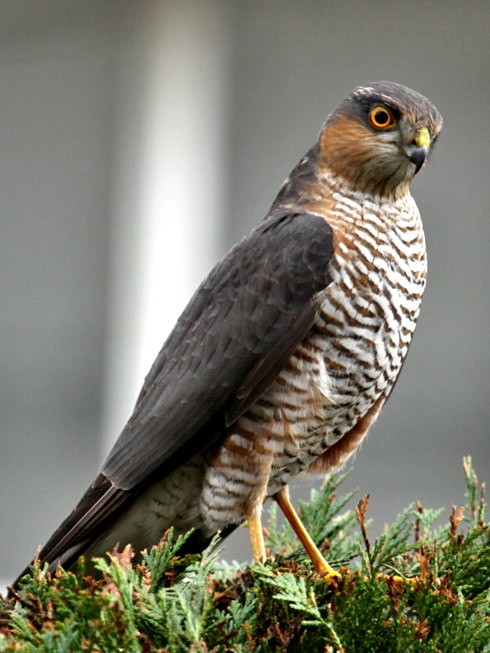

The blue colour of this dish has faded due to the cobalt-based pigment used (following the actual appearance of kraak porcelain, it would have originally been much brighter). Several plates and bowls of white kraak porcelain are stacked on top of a blue and white kraak plate that Peeters repeated in several paintings. The soft bodies and feathers of the birds are contrasted in the right section of the painting with the hard, fine surface of porcelain and shells. They could be used to feed it, or they could be in the painting simply as food for people, not birds. The smaller birds in this picture could be the sparrow hawk’s prey the mallard and hen are too large. The small birds that hang by their neck from a small branch are finches, with their winter plumage, which is less colourful than during their mating season in the summer. Peeters painted this bird on other occasions she may have chosen it for its striking red colour, which is beautifully combined with the green head of the mallard. The small red bird to the right is a male common bullfinch. Next to the pigeons is a thrush, and hanging over the rim of the basket is the head of another bird of the same species. They have been plucked in preparation for cooking the same would presumably soon happen to the rest of the birds. Two young pigeons are displayed on a red clay plate. We can gain a sense of the effect of the tail on the original composition in the infrared image of the picture. In its original state it must have added a strong accent that rhymed with the head of the mallard and contrasted with its red feet.

The green colour of the tail has aged and become a dark tone, a transformation typical of green glaze copper pigments. The larger birds in the painting are a male mallard (in the basket), a woodcock, a hen (to the left, its head hanging from the table or ledge), and a rooster, with its tail barely visible in the background. It is a female, which are larger than males. Perched on the rim of a wicker basket is a Eurasian sparrow hawk painted approximately life-size. A mallard very similar to this, but reversed, is included in another still life by the artist.

This type of adjustment is characteristic of the paintings of Clara Peeters. The head of the bird that emerges from under the aforementioned wing was added after the basket had been painted. There are some pentimenti along the contours of the left wing of the mallard, which was originally larger. As is the case in most paintings by Clara Peeters, the fairly thin paint layers allow this streaky priming to show through in some areas, providing a sense of texture and a luminous, radiant effect.

In the light areas of the infrared photo the streaky imprimatura applied in preparation for painting is visible. More underdrawing must exist, but it is not detectable. The infrared image of the painting reveals some underdrawing in the shells, along the contour of the plate (near the signature), in the beaks of some of the birds and in some areas of the rooster’s tail in the background. This painting, together with Still life with Fish, Candle, Artichokes, Crabs and Shrimp, also in the Prado ( P1621), is very likely identical to a picture first documented when it was in the Spanish royal collection in Madrid in 1666.


 0 kommentar(er)
0 kommentar(er)
